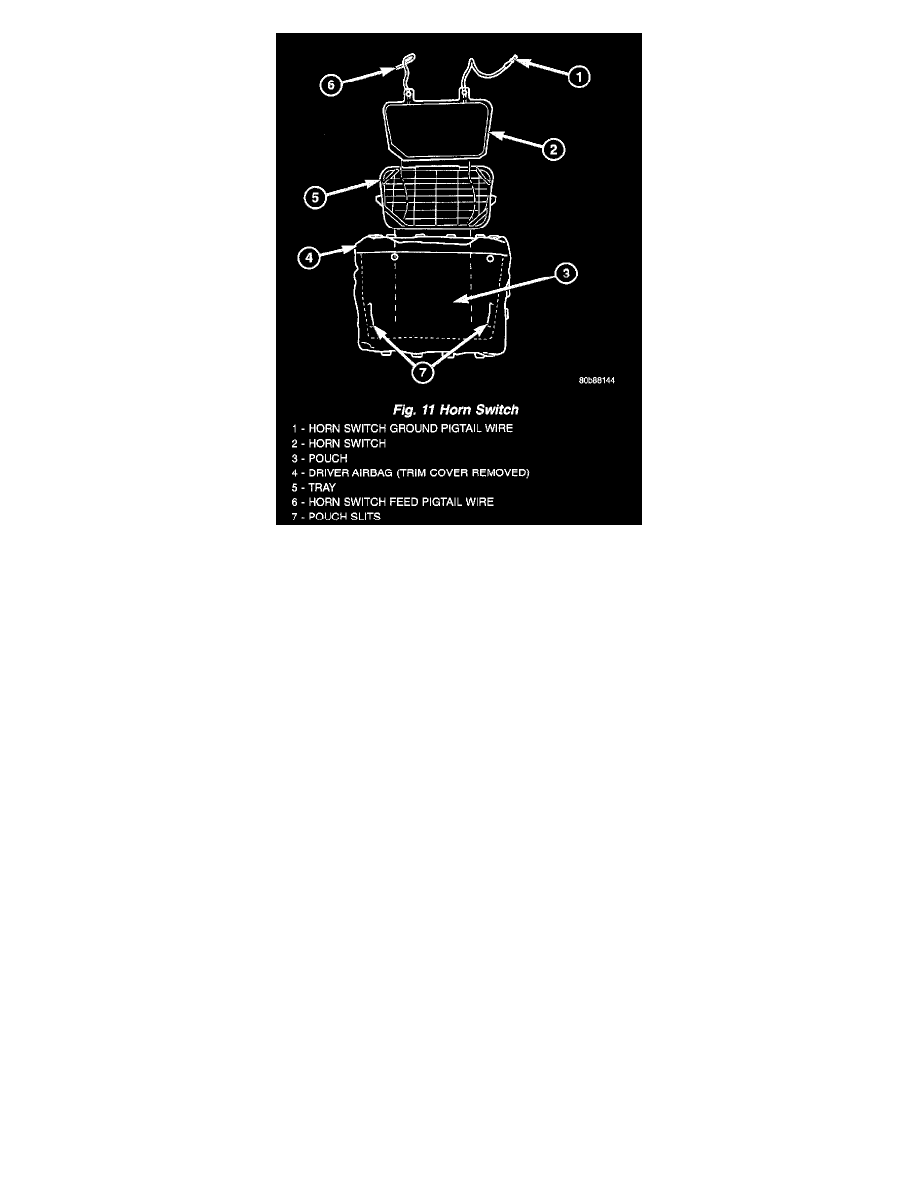Dakota Quad Cab 2WD V8-5.9L VIN Z LDC (2002)

Fig.11 Horn Switch
The resistive membrane-type horn switch is secured within a plastic tray that is inserted in a pocket or pouch sewn onto the airbag cushion retainer
strap, between the trim cover and the folded airbag cushion. One horn switch pigtail wire has an eyelet terminal connector that is captured beneath
a nut and washer on the upper right inflator mounting stud. The other horn switch pigtail wire is routed between the upper left inflator mounting
stud and the inflator, where it is captured by a small plastic retainer that is pushed onto the stud.
The airbag used in this model is a Next Generation-type that complies with revised federal airbag standards to deploy with less force than those
used in some prior models. A 65 centimeter (25.5 inch) diameter, radial deploying fabric cushion with internal tethers is used. The airbag inflator
is a conventional non-azide, pyrotechnic-type unit with a flange and four studs that also serves as the airbag cushion retainer and is secured to the
stamped metal airbag housing with four nuts. A connector receptacle on the driver airbag inflator connects the inflator initiator to the vehicle
electrical system through a yellow-jacketed, two-wire pigtail harness of the clockspring.
The driver airbag cannot be repaired, and must be replaced if deployed or in any way damaged. The driver airbag trim cover and the horn switch
with tray may be disassembled from the driver airbag unit, and are available for separate service replacement.
The driver airbag is deployed by an electrical signal generated by the Airbag Control Module (ACM) through the driver airbag squib circuit to the
initiator in the airbag inflator. When the ACM sends the proper electrical signal to the initiator, the electrical energy generates enough heat to
initiate a small pyrotechnic charge which, in turn ignites chemical pellets within the inflator. Once ignited, these chemical pellets burn rapidly and
produce a large quantity of inert gas. The inflator is sealed to the back of the airbag housing and a diffuser in the inflator directs all of the inert gas
into the airbag cushion, causing the cushion to inflate. As the cushion inflates, the driver airbag trim cover will split at predetermined breakout
lines, then fold back out of the way along with the horn switch and tray unit. Following an airbag deployment, the airbag cushion quickly deflates
by venting the inert gas towards the instrument panel through the porous fabric material used to construct the back (steering wheel side) panel of
the airbag cushion.
Some of the chemicals used to create the inert gas may be considered hazardous while in their solid state before they are burned, but they are
securely sealed within the airbag inflator. Typically, all potentially hazardous chemicals are burned during an airbag deployment event. The inert
gas that is produced when the chemicals are burned is harmless. How- ever, a small amount of residue from the burned chemicals may cause some
temporary discomfort if it contacts the skin, eyes, or breathing passages. If skin or eye irritation is noted, rinse the affected area with plenty of
cool, clean water. If breathing passages are irritated, move to another area where there is plenty of clean, fresh air to breath. If the irritation is not
alleviated by these actions, contact a physician.
PASSENGER AIRBAG
The rearward facing surface of the passenger air- bag door above the glove box is the most visible part of the passenger airbag. The airbag used in
this model is a Next Generation-type that complies with revised federal airbag standards to deploy with less force than those used in some prior
models. The passenger airbag is located in the instrument panel in front of the front seat passenger seating position, where it is secured to the
